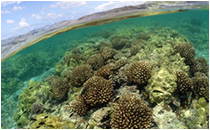Introduction to Papahānaumokuākea Marine National Monument
 As one of the largest World Heritage sites on the planet and one of the world’s largest Marine Protected Areas (MPA), Papahānaumokuākea Marine National Monument is a vast oceanic expanse in the North Pacific Ocean. Its string of tiny islands, atolls, reefs and shoals span a distance equivalent to that from Washington, D.C. to Houston, Texas, or the distance from London, England, to Reykjavik, Iceland. Comprising the northwestern three-quarters of the world’s longest and most remote island chain, Papahānaumokuākea is the clearest progression, and oldest example of island formation and atoll evolution in the world, spanning 28 million years.
As one of the largest World Heritage sites on the planet and one of the world’s largest Marine Protected Areas (MPA), Papahānaumokuākea Marine National Monument is a vast oceanic expanse in the North Pacific Ocean. Its string of tiny islands, atolls, reefs and shoals span a distance equivalent to that from Washington, D.C. to Houston, Texas, or the distance from London, England, to Reykjavik, Iceland. Comprising the northwestern three-quarters of the world’s longest and most remote island chain, Papahānaumokuākea is the clearest progression, and oldest example of island formation and atoll evolution in the world, spanning 28 million years.
At both the regional and global levels, Papahānaumokuākea is a rich reserve of outstanding spiritual, scientific, conservation and aesthetic value where nature and culture are one. Papahānaumokuākea is the first site ever inscribed with living, indigenous cultural connections to the sea. Hawaiian wayfinders (non-instrument navigators) still voyage for navigational training on traditional double-hulled sailing canoes; an aspect of inscription unique to Papahānaumokuākea. The region is also a deeply spiritual and sacred place. In predominant Native Hawaiian cosmology, the Northwestern Hawaiian Islands are where all life originates and where ancestors return after death.
The Monument also protects a wide array of ocean and terrestrial species and is home to many endangered and threatened species such as the critically endangered Hawaiian monk seal. Sharks and other large apex predators dominate the ocean landscape and 14 million seabirds, which nest and forage in the region, also make Papahānaumokuākea the largest tropical seabird rookery in the world.
